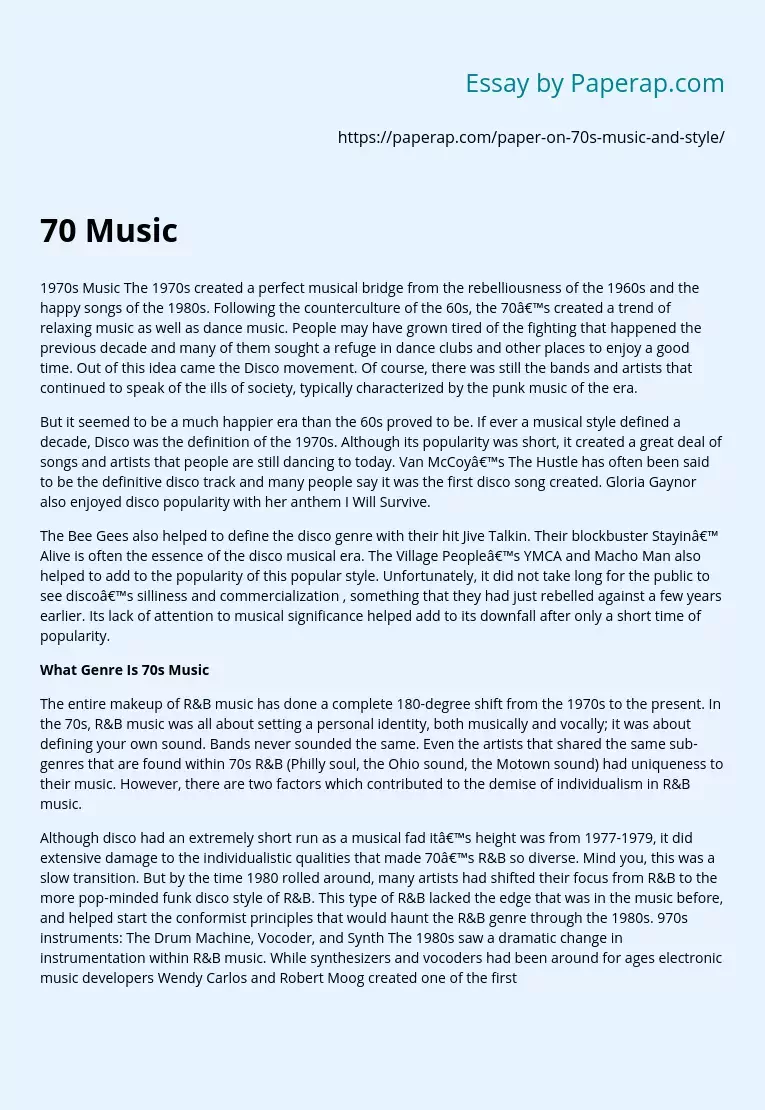1970s Music The 1970s created a perfect musical bridge from the rebelliousness of the 1960s and the happy songs of the 1980s. Following the counterculture of the 60s, the 70’s created a trend of relaxing music as well as dance music. People may have grown tired of the fighting that happened the previous decade and many of them sought a refuge in dance clubs and other places to enjoy a good time. Out of this idea came the Disco movement. Of course, there was still the bands and artists that continued to speak of the ills of society, typically characterized by the punk music of the era.
But it seemed to be a much happier era than the 60s proved to be. If ever a musical style defined a decade, Disco was the definition of the 1970s. Although its popularity was short, it created a great deal of songs and artists that people are still dancing to today. Van McCoy’s The Hustle has often been said to be the definitive disco track and many people say it was the first disco song created.
Gloria Gaynor also enjoyed disco popularity with her anthem I Will Survive.
The Bee Gees also helped to define the disco genre with their hit Jive Talkin. Their blockbuster Stayin’ Alive is often the essence of the disco musical era. The Village People’s YMCA and Macho Man also helped to add to the popularity of this popular style. Unfortunately, it did not take long for the public to see disco’s silliness and commercialization , something that they had just rebelled against a few years earlier.
Its lack of attention to musical significance helped add to its downfall after only a short time of popularity.
What Genre Is 70s Music
The entire makeup of R&B music has done a complete 180-degree shift from the 1970s to the present. In the 70s, R&B music was all about setting a personal identity, both musically and vocally; it was about defining your own sound. Bands never sounded the same. Even the artists that shared the same sub-genres that are found within 70s R&B (Philly soul, the Ohio sound, the Motown sound) had uniqueness to their music. However, there are two factors which contributed to the demise of individualism in R&B music.
Although disco had an extremely short run as a musical fad it’s height was from 1977-1979, it did extensive damage to the individualistic qualities that made 70’s R&B so diverse. Mind you, this was a slow transition. But by the time 1980 rolled around, many artists had shifted their focus from R&B to the more pop-minded funk disco style of R&B. This type of R&B lacked the edge that was in the music before, and helped start the conformist principles that would haunt the R&B genre through the 1980s. 970s instruments: The Drum Machine, Vocoder, and Synth The 1980s saw a dramatic change in instrumentation within R&B music. While synthesizers and vocoders had been around for ages electronic music developers Wendy Carlos and Robert Moog created one of the first musical vocoders in 1970. The drum machine was a fairly new development, and the most crucial implement in the shift from idiosyncratic R&B to the more conventional R&B that would be the norm through the 1980s, and even through to today. The Linn LM-1 Drum Computer (released in 1980; was the first drum machine to use digital samples. Only 500 were ever made, but the list of those who owned them was impressive. Its distinct sound almost defines 80s pop, and it can be heard on dozens of hit records from the era, including The Human League’s Dare, Gary Numan’s Dance, and Ric Ocasek’s Beatitude. Prince bought one of the very first LM-1s and used it on nearly all of his most popular recordings, including 1999 and Purple Rain. “
Although this quote singles out pop music, the same can also be applied to R&B. Artists were starting to shift toward a single defined sound, and this even morphed into new jack swing heading into the 1990s. This trend continues today, with artists not differing in instrumental or vocal style. As you can see, R&B music has definitely changed from the 70’s distinctive attitudes to the present-day attitudes. Unfortunately, I don’t believe that R&B will return to the state it was, where one voice differed from another, and the music was unique to its artist.
70's Music Genre and Style Research. (2019, Dec 05). Retrieved from https://paperap.com/paper-on-70s-music-and-style/

